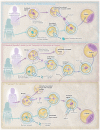The fountain of youth of mitochondrial research: Research is targeting mitochondrial dysfunction to tackle aging and much more, but hype is an increasing concern
- PMID: 37768688
- PMCID: PMC10561170
- DOI: 10.15252/embr.202358118
The fountain of youth of mitochondrial research: Research is targeting mitochondrial dysfunction to tackle aging and much more, but hype is an increasing concern
Abstract
A new wave of studies is untangling the connection between primary genetic mitochondrial diseases and the role of mitochondria in aging: what are the implications for longevity?
© 2023 The Authors.
Figures





References
-
- Bitto A, Grillo AS, Ito TK, Stanaway IB, Nguyen BMG, Ying K, Tung H, Smith K, Tran N, Velikanje G et al (2023) Acarbose suppresses symptoms of mitochondrial disease in a mouse model of Leigh syndrome. Nat Metab 5: 955–967 - PubMed
-
- Chinnery PF (2020) Mitochondrial replacement in the clinic. N Engl J Med 382: 1855–1857 - PubMed
-
- Grillo AS, Bitto A, Kaeberlein M (2021) The NDUFS4 knockout mouse: a dual threat model of childhood mitochondrial disease and normative aging. Methods Mol Biol 2277: 143–155 - PubMed
MeSH terms
Substances
LinkOut - more resources
Full Text Sources
Medical

